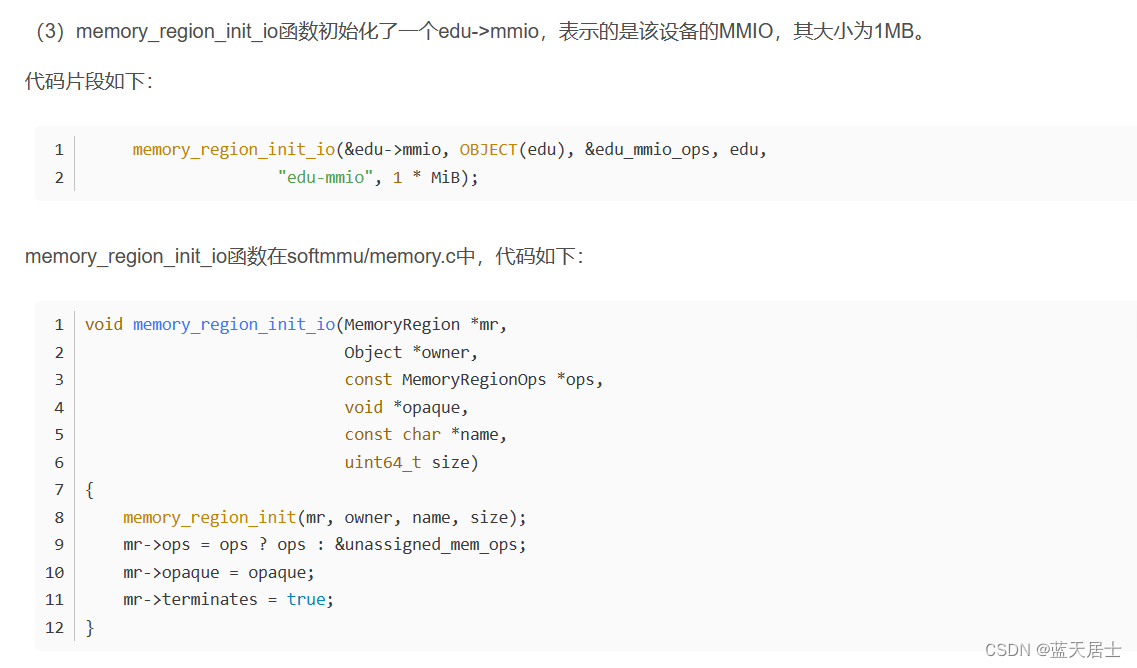接前一篇文章:
上一回讲解了pci_edu_realize函数中的pci_register_bar函数,本回开始对于edu设备的MMIO读写函数进行解析。
操作系统与PCI设备交互的主要方式是PIO和MMIO。MMIO虽然是一段内存,但是其没有EPT映射,在虚拟机访问设备的MMIO时,会产生VM Exit;KVM识别此MMIO访问并且将该访问分派到应用层QEMU中;QEMU根据内存虚拟化的步骤进行分派,找到设备注册的MMIO读写回调函数;设备的MMIO读写回调函数根据设备的功能进行模拟,完成模拟之后可能会发送中断到虚拟机中,从而完成一些MMIO访问。
前文书(QEMU源码全解析 —— PCI设备模拟(5))已经讲过,pci_edu_realize函数中调用memory_region_init_io函数,指定其读写函数是edu_mmio_ops。

edu_mmio_ops在hw/misc/edu中初始化,代码如下:
static const MemoryRegionOps edu_mmio_ops = {.read = edu_mmio_read,.write = edu_mmio_write,.endianness = DEVICE_NATIVE_ENDIAN,.valid = {.min_access_size = 4,.max_access_size = 8,},.impl = {.min_access_size = 4,.max_access_size = 8,},};edu_mmio_ops的类型为MemoryRegionOps,此结构在include/exec/memory.h中定义,代码如下:
typedef struct MemoryRegionOps MemoryRegionOps;而struct MemoryRegionOps的定义也在include/exec/memory.h中,如下:
/** Memory region callbacks*/
struct MemoryRegionOps {/* Read from the memory region. @addr is relative to @mr; @size is* in bytes. */uint64_t (*read)(void *opaque,hwaddr addr,unsigned size);/* Write to the memory region. @addr is relative to @mr; @size is* in bytes. */void (*write)(void *opaque,hwaddr addr,uint64_t data,unsigned size);MemTxResult (*read_with_attrs)(void *opaque,hwaddr addr,uint64_t *data,unsigned size,MemTxAttrs attrs);MemTxResult (*write_with_attrs)(void *opaque,hwaddr addr,uint64_t data,unsigned size,MemTxAttrs attrs);enum device_endian endianness;/* Guest-visible constraints: */struct {/* If nonzero, specify bounds on access sizes beyond which a machine* check is thrown.*/unsigned min_access_size;unsigned max_access_size;/* If true, unaligned accesses are supported. Otherwise unaligned* accesses throw machine checks.*/bool unaligned;/** If present, and returns #false, the transaction is not accepted* by the device (and results in machine dependent behaviour such* as a machine check exception).*/bool (*accepts)(void *opaque, hwaddr addr,unsigned size, bool is_write,MemTxAttrs attrs);} valid;/* Internal implementation constraints: */struct {/* If nonzero, specifies the minimum size implemented. Smaller sizes* will be rounded upwards and a partial result will be returned.*/unsigned min_access_size;/* If nonzero, specifies the maximum size implemented. Larger sizes* will be done as a series of accesses with smaller sizes.*/unsigned max_access_size;/* If true, unaligned accesses are supported. Otherwise all accesses* are converted to (possibly multiple) naturally aligned accesses.*/bool unaligned;} impl;
};
其中的read和Write函数分别表示该MMIO的读写回调;endianness表示字节的大小端模式。
以write回调函数为例,
/* Write to the memory region. @addr is relative to @mr; @size is* in bytes. */void (*write)(void *opaque,hwaddr addr,uint64_t data,unsigned size);static void edu_mmio_write(void *opaque, hwaddr addr, uint64_t val,unsigned size)其原型中的opaque表示的是设备的对象;addr表示虚拟机读的地址在该MMIO中的偏移地址;data(val)表示要写入的值;size表示写入值的大小,通常由单字节、双字节、四字节以及八字节。
edu_mmio_write函数同样在hw/misc/edu.c中,代码如下:
static void edu_mmio_write(void *opaque, hwaddr addr, uint64_t val,unsigned size)
{EduState *edu = opaque;if (addr < 0x80 && size != 4) {return;}if (addr >= 0x80 && size != 4 && size != 8) {return;}switch (addr) {case 0x04:edu->addr4 = ~val;break;case 0x08:if (qatomic_read(&edu->status) & EDU_STATUS_COMPUTING) {break;}/* EDU_STATUS_COMPUTING cannot go 0->1 concurrently, because it is only* set in this function and it is under the iothread mutex.*/qemu_mutex_lock(&edu->thr_mutex);edu->fact = val;qatomic_or(&edu->status, EDU_STATUS_COMPUTING);qemu_cond_signal(&edu->thr_cond);qemu_mutex_unlock(&edu->thr_mutex);break;case 0x20:if (val & EDU_STATUS_IRQFACT) {qatomic_or(&edu->status, EDU_STATUS_IRQFACT);/* Order check of the COMPUTING flag after setting IRQFACT. */smp_mb__after_rmw();} else {qatomic_and(&edu->status, ~EDU_STATUS_IRQFACT);}break;case 0x60:edu_raise_irq(edu, val);break;case 0x64:edu_lower_irq(edu, val);break;case 0x80:dma_rw(edu, true, &val, &edu->dma.src, false);break;case 0x88:dma_rw(edu, true, &val, &edu->dma.dst, false);break;case 0x90:dma_rw(edu, true, &val, &edu->dma.cnt, false);break;case 0x98:if (!(val & EDU_DMA_RUN)) {break;}dma_rw(edu, true, &val, &edu->dma.cmd, true);break;}
}
edu_mmio_write函数展示了一个虚拟机在写设备MMIO地址时QEMU中设备模拟的典型行为。
(1)首先,需要检查读写地址以及大小是否在范围之内。代码片段如下:
if (addr < 0x80 && size != 4) {return;}if (addr >= 0x80 && size != 4 && size != 8) {return;}(2)然后,根据具体的地址来进行适当的行为。
这些行为可以是简单地设置一个值,如这里的写0x04地址,代码片段如下:
case 0x04:edu->addr4 = ~val;break;也可以是将中断设置为高电平(写0x60地址)或者设置为低电平(写0x64地址),代码片段如下:
case 0x60:edu_raise_irq(edu, val);break;case 0x64:edu_lower_irq(edu, val);break;还可以是通过dma读写设备虚拟机的物理地址(写0x80地址),代码片段如下:
case 0x80:dma_rw(edu, true, &val, &edu->dma.src, false);break;对于read回调函数,也是类似的机制。这里仅给出edu_mmio_read函数源码,在hw/misc/edu.c中,代码如下:
static uint64_t edu_mmio_read(void *opaque, hwaddr addr, unsigned size)
{EduState *edu = opaque;uint64_t val = ~0ULL;if (addr < 0x80 && size != 4) {return val;}if (addr >= 0x80 && size != 4 && size != 8) {return val;}switch (addr) {case 0x00:val = 0x010000edu;break;case 0x04:val = edu->addr4;break;case 0x08:qemu_mutex_lock(&edu->thr_mutex);val = edu->fact;qemu_mutex_unlock(&edu->thr_mutex);break;case 0x20:val = qatomic_read(&edu->status);break;case 0x24:val = edu->irq_status;break;case 0x80:dma_rw(edu, false, &val, &edu->dma.src, false);break;case 0x88:dma_rw(edu, false, &val, &edu->dma.dst, false);break;case 0x90:dma_rw(edu, false, &val, &edu->dma.cnt, false);break;case 0x98:dma_rw(edu, false, &val, &edu->dma.cmd, false);break;}return val;
}
欲知后事如何,且看下回分解。

)




 v25 直装版 支持win/mac版)

- ADC采集电压)










